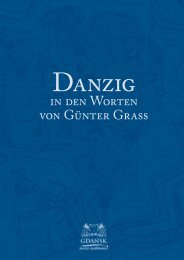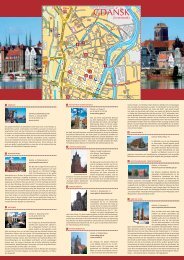G D A Ń S K
G D A Ń S K
G D A Ń S K
Create successful ePaper yourself
Turn your PDF publications into a flip-book with our unique Google optimized e-Paper software.
Profound Revitalisation<br />
Gdańsk is one of the pioneer cities in Poland to have<br />
developed a comprehensive programme of revitalising its<br />
urban area. The venture planned for the next 25 years will<br />
be financed from the municipal budget and the EU funds.<br />
The idea behind the project is to boost social and economic<br />
activity in the districts degraded by the industry or military.<br />
It further comprises the districts that have been ‘forgotten’<br />
in all revitalisation processes since the war.<br />
The selection of the areas to be included in the revitalisation<br />
venture was made based on several criteria. The decisive<br />
factors included high unemployment, social exclusion and<br />
poverty, low education among the local community, and<br />
low enterprise initiative. These social criteria were<br />
supplemented with environmental pollution, the density of<br />
architecture of cultural value, poor technical condition of<br />
the existing buildings and scarcity of the technical<br />
infrastructure. The aspect of the economic potential inherent<br />
in the area was also taken into consideration.<br />
The application of a single criterion out of those mentioned<br />
above during the programme building exercise yielded a<br />
list of as many as 60 areas adding up to two third parts of<br />
the city’s entire built-up land. Out of these 13 quarters were<br />
short-listed as priority areas, i.e.: Jelitkowo, Brzeźno, Nowy<br />
Port [New Port], Kolonia Abegga, Lower Wrzeszcz, Grodzisko<br />
[Stronghold], Biskupia Górka [Bishop’s Hillock], the Old Suburb,<br />
Granary Island, Lower City, Angielska Grobla - Długie Ogrody<br />
[English Dyke – Long Gardens], Święty Wojciech [St Adalbert],<br />
and Orunia.<br />
Stage one of the programme envisages revitalisation of the<br />
Lower City and Grodzisko [Stronghold]. The first effects of<br />
the efforts are already to be seen. The 19. century Grodzisko<br />
fortress has, thanks to the ‘Hevelianum Centre’ project,<br />
obtained EU funds from the Integrated Regional Development<br />
Operating Programme. With the Hevelianum project carried<br />
through, the parkland around the hill and its historic<br />
fortifications will be transformed into a centre of education<br />
and recreation for the Gdańsk residents and visitors.<br />
New investments have also entered other city quarters<br />
included in the revitalisation plan. Housing estates are being<br />
built on the Motława River in the Old Suburb. The investors<br />
here include Invest Komfort, a locally known developer. In<br />
Jelitkowo, the municipal investments in the recreational<br />
infrastructure have gone hand in hand with the now<br />
completed project of erecting a luxurious suite compound<br />
overlooking the sea. In the Lower Wrzeszcz area, the site<br />
previously occupied by the Gdańsk brewery has changed<br />
its owners. The purchasers, namely the Pomeranian<br />
developers: PB Górski and Hossa SA, intend to transform this<br />
excellently located post-industrial estate into a modern<br />
district combining the residential and service functions.<br />
1





